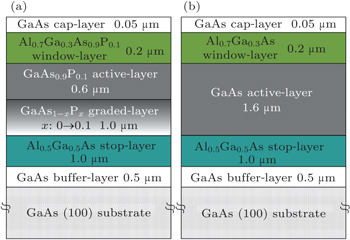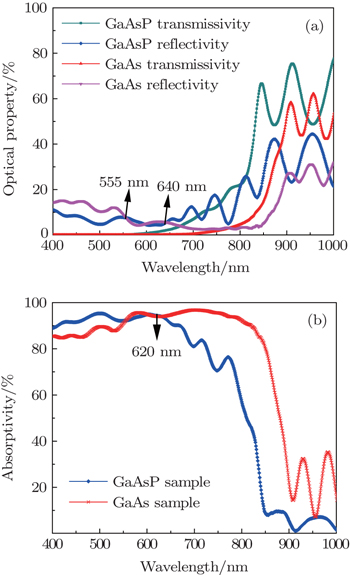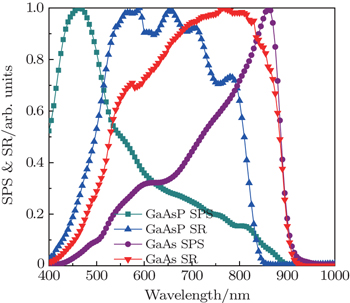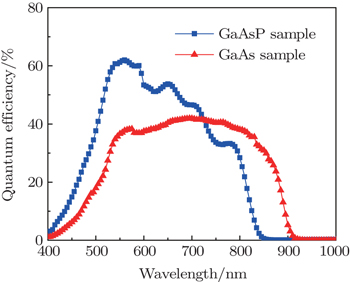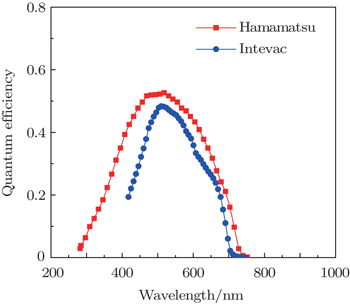† Corresponding author. E-mail:
Project supported by the National Natural Science Foundation of China (Grant No. 61301023) and the Science and Technology on Low-Light-Level Night Vision Laboratory Foundation, China (Grant No. BJ2014001).
In order to develop the photodetector for effective blue–green response, the 18-mm-diameter vacuum image tube combined with the transmission-mode Al0.7Ga0.3As0.9P0.1/GaAs0.9P0.1 photocathode grown by molecular beam epitaxy is tentatively fabricated. A comparison of photoelectric property, spectral characteristic and performance parameter between the transmission-mode GaAsP-based and blue-extended GaAs-based photocathodes shows that the GaAsP-based photocathode possesses better absorption and higher quantum efficiency in the blue–green waveband, combined with a larger surface electron escape probability. Especially, the quantum efficiency at 532 nm for the GaAsP-based photocathode achieves as high as 59%, nearly twice that for the blue-extended GaAs-based one, which would be more conducive to the underwater range-gated imaging based on laser illumination. Moreover, the simulation results show that the favorable blue–green response can be achieved by optimizing the emission-layer thickness in a range of 0.4 μm–0.6 μm.
In the last two decades, negative electron affinity (NEA) GaAsP-based photocathodes are of great technological interest and have found widespread application in various fields such as weak light imaging, high energy physics, astronomical observation and underwater photodetection.[1–4] As is well known, GaAsP-based photocathodes are divided into two basic types, i.e., reflection-mode (r-mode) cathodes for which the light is incident on the electron emission surface and transmission-mode (t-mode) cathodes for which the light is incident on the back surface.
For the r-mode operation, the GaAsP-based photocathode is a promising candidate as an electron source in the high voltage DC photogun due to its low thermal emittance and fast temporal response time.[5] Recently, by means of strained GaAs/GaAsP superlattice structures, the electron-spin polarization reached as high as 92% with a quantum efficiency exceeding 1%.[6,7] For t-mode operation, because of the high quantum efficiency in the visible spectrum, GaAsP photocathodes serve as core components in various photodetectors. For instance, a new type of hybrid photodiode (HPD) consisting of an 18-mm-diameter GaAsP photocathode and an avalanche diode serving as an anode was developed for the major atmospheric gamma-ray imaging Cherenkov (MAGIC) telescope camera.[8,9] Besides, GaAsP photocathode-based image intensifiers with high blue–green light response can provide effective means for laser illuminating range-gated imaging underwater and ultra-fast single-photon counting.[10–12]
Despite many prominent advantages and broad applications, there has been no significant progress over the last few decades in developing high-performance t-mode GaAsP-based photocathodes due to the complexity of the preparation process. Currently, the commercially available photodetectors with using t-mode GaAsP photocathodes, such as the image intensifier, photomultiplier and HPD have only come from two corporations, i.e., Hamamatsu and Intevac.[3] Indeed, the quality of epitaxial GaAsP-based heterojunction materials is extremely crucial to the device performance. As is well known, t-mode GaAsP-based cathode materials from Hamamatsu and Intevac are grown by metal-organic chemical vapor deposition (MOCVD) and vapor phase epitaxy (VPE).[1,13] In this paper, a type of t-mode GaAsP cathode material is tentatively fabricated by molecular beam epitaxy (MBE), and the packed 18-mm-diameter image intensifier including the activated GaAsP photocathode module is fabricated. In order to verify the actual effect of blue–green response enhancement, a blue-extended GaAs photocathode-based image intensifier as a comparison object is also fabricated. Meanwhile, the differences in photoelectric property, spectral characteristic and performance parameter between the two types of photocathodes are analyzed.
Like the AlGaAs/GaAs double heterostructures described by Antypas and Edgecumbe,[14] the universal inverted structure is applied to the t-mode GaAsP-based photocathodes. However, differing from the lattice-matched AlGaAs/GaAs heterostructure, both heterostructures like GaAsP/GaAs and AlGaAsP/GaAs are lattice mismatched systems. The misfit dislocation and stacking fault arising from the lattice mismatch between substrate and epitaxial layer would dramatically deteriorate the photoemission capability. As for GaAs1−xPx ternary alloy, the dependence of the band gap of GaAs1−xPx alloy on the P composition x is given by[15]


In order to verify the enhancement of the blue–green response for the GaAsP-based photocathode, another type of blue-extended t-mode photocathode consisting of the AlGaAs/GaAs heterostructure was prepared as well. The inverted structures for the two t-mode photocathode samples are shown in Fig.
After the growth, the surface photovoltage spectroscopy (SPS) data for the cleaned epitaxial materials were measured to predict the cathode emission performance, since there are many similarities between SPS and spectral response (SR), which are both related to the inherent material performance factors.[18] Following that, as the proposed process of fabricating t-mode GaAs photocathodes by Antypas and Edgecumbe,[14] the cap-layer was first removed with a properly selective etch to expose the window-layer to coat the Si3N4 antireflection film on it. Then the glass was thermocompression bonded to the full wafer structure to support the fragile epilayers. After that, the substrate, stop-layer and graded-layer were selectively etched away to expose the emission-layer to perform the activation. Finally, the AlGaAsP/GaAsP and AlGaAs/GaAs samples were made into the 18-mm-diameter cathode module with a glass/Si3N4/window-layer/emisison-layer structure. Based on the double optical path method, the spectrophotometer typed UV-3600 was adopted to measure the reflectivity and transmissivity curves of the module samples in a range of 400 nm–1000 nm. When measured, photons entered into the modules in the near normal incidence on the glass layer.
Following chemical etching and heat cleaning, the NEA activation for the cathode modules was performed in an ultrahigh vacuum chamber with a base pressure of ≤ 10−9 Pa by using the co-deposition activation technique,[19] in which the cesium source was kept constant and the oxygen source was introduced periodically. For both the samples, the Cs/O flux ratio was adjusted to be the same value. After the usual “high-low temperature” two-step activation, the cathode module was transferred from the activation chamber to the sealed vacuum chamber and indium sealed into a vacuum image tube, in which the activated cathode module was equipped in association with the microchannel plate and fluorescence screen. Finally, the spectral response of the sealed image tube after being transferred into ambient air was measured by the spectral response measurement system.[20]
The experimental curves of optical properties are given in Fig.
Using the monochromator combined with a tungsten halogen lamp, the measured normalized SPS and SR curves for the two samples are shown in Fig.
The experimental quantum yield curves for the t-mode GaAsP- and GaAs-based cathode samples sealed in the vacuum image tubes are shown in Fig.
The quantum efficiency curves of foreign t-mode GaAsP photocathodes from Hamamatsu and Intevac are shown in Fig.
| Table 1. Spectral characteristics of this work and t-mode GaAsP photocathodes from Hamamatsu and Intevac. . |
In order to evaluate the important intrinsic cathode performance parameters such as electron diffusion length, back interface recombination velocity and surface electron escape probability of the two different t-mode photocathodes, we compare the measured quantum efficiency curves with the theoretical curves respectively according to the t-mode uniform-doping quantum efficiency equation, which is given by[23]

When simulating the theoretical quantum yield curves, about the absorption coefficient values varying with wavelength in the layers like GaAs, Al0.7Ga0.3As and GaAs0.9P0.1 we referred to Refs. [24] and [25]. Nevertheless, in the absence of any reference about the absorption coefficient of the Al0.7Ga0.3As0.9P0.1 window-layer in the t-mode GaAsP photocathode, about the absorption coefficient of Al0.7Ga0.3As0.9P0.1 alloy with the low P composition we just referred to that of Al0.7Ga0.3As alloy. By using Eq. (
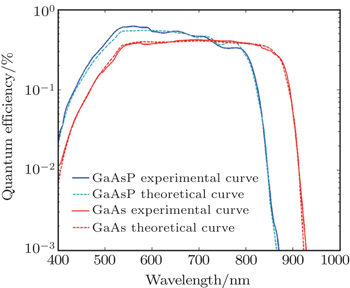 | Fig. 6. Experimental and theoretical quantum efficiency curves of t-mode GaAsP and GaAs cathode samples. |
From Fig.
| Table 2. Fitted performance parameters of t-mode GaAsP and GaAs cathode samples. . |
With an attempt to clarify the difference in surface electron escape probability between GaAsP and GaAs photocathodes, we should carry on an investigation into the inner band structure and surface barrier, which is shown in Fig.
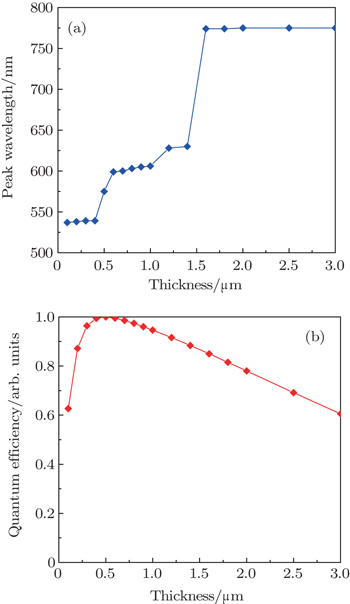 | Fig. 8. Theoretical changes of (a) peak wavelength and quantum efficiency at 532 nm with emission-layer thickness. |
In order to obtain the optimum thickness of the GaAs0.9P0.1 emission-layer for better blue–green response, we investigate the effects of emission-layer thickness on peak wavelength and quantum efficiency at 532 nm, respectively, and the simulation results are shown in Fig.
In the present article, we have fabricated an 18-mm-diameter vacuum image tube incorporating the t-mode Al0.7Ga0.3As0.9P0.1/GaAs0.9P0.1 photocathode grown by MBE. A comparison of photoelectric property, spectral characteristic and performance parameter between the t-mode GaAsP-based and blue-extended GaAs-based photocathodes shows that the t-mode GaAsP-based photocathode achieves better absorption, higher quantum efficiency and narrower spectrum range in the blue–green waveband. Besides, the quantum efficiency of the t-mode GaAsP-based photocathode reaches as high as 59% at 532 nm, which is nearly twice that of the t-mode GaAs-based one. The simulation results show that the optimum thickness of the emission-layer is in a range of 0.4 μ–0.6 μm, which is advantageous to range-gated imaging underwater. This work could provide a reference for further improving the performance of the t-mode GaAsP-based photocathode for better blue–green response.
| 1 | |
| 2 | |
| 3 | |
| 4 | |
| 5 | |
| 6 | |
| 7 | |
| 8 | |
| 9 | |
| 10 | |
| 11 | |
| 12 | |
| 13 | |
| 14 | |
| 15 | |
| 16 | |
| 17 | |
| 18 | |
| 19 | |
| 20 | |
| 21 | |
| 22 | |
| 23 | |
| 24 | |
| 25 | |
| 26 |



